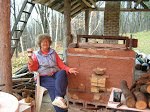Last year I attended an estate sale in my town. It belonged to an early member of the Deep River Potters Guild who was a member in the 60's and early 70's. I bought several of his early pieces to give ti our Guild for the "Former Members Gallery". They were bright orange and yellow.- a testament to when lead glazes were popular. However what attracted me was his collection of pottery books - including "Ceramics Design" by John B. Kenny published in 1963. Although dated in terms of design, it is nevertheless inspiring with lots of great ideas.
In the forward about what is design he writes - ."..to a ceramist, design means more than that (arrangement of detail) - much more. It means order out of chaos; form out of shapeless mass...... It is something for which he must search, and when he finds it, his work is satisfying and good. His quest is never ended - he must go on searching as long as he lives and works." Great words to live by!
However the best part of the book for me was the chapter titled "Draw!" Very few pottery books go into any detail on how to go about practicing your drawing for pottery - he devotes 9 pages to it and outlines various exercises that one can do to practice drawing.
1.Keep a sketch book and use it frequently.
2. If you are not used to drawing he suggests you start by making quick sketches of things you see - don't worry about being accurate.
3. Look at an object for a few minutes and then draw it with your eyes closed
4. Make a drawing of a familiar object without looking at it.
5. Warm-up exercise - stretch out your arms and draw in the air - write your name and write it backwards.
6. Make memory drawings of people doing things - playing an instrument, kicking a ball etc.
7. Do large quick drawing on a blackboard - bold sweeping continuous lines. Seeing white lines on a black lets you see drawings as negatives and you get a different perspective.
8.Try drawing with different things - pen, pencil, bushes.
9. Try using newspaper for brushwork - practice with brushstrokes to show expression, images with just one continuous brush stroke.
To help with ceramic form and decoration -
1. Draw outlines of various ceramic forms - symmetrical, asymmetrical.
2. Draw your form - circle for a plate and draw various vertical and horizontal lines, wavy and straight, thick and thin .
3. On square plates try out patterns of rectangles, overlapping different colours, some with designs within them.
4. Try out stencils with dabbing on colour with a sponge. Overlap different sponges.
5. Use dots, wandering lines.
6. Use a "design finder" - cut out a 3" square hole in a piece of paper and and move it over your designs to find the best section.
And his final advice - take good care of your sketch book - it will provide a rich source of inspiration for years to come. I still have my sketch books from the 60's and 70's and it's really interesting to see what how my interests and styles have changed.
Peach Bloom
3 hours ago









